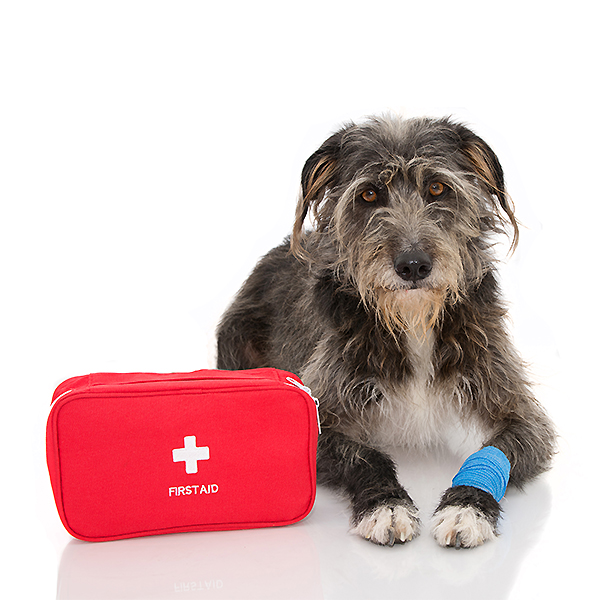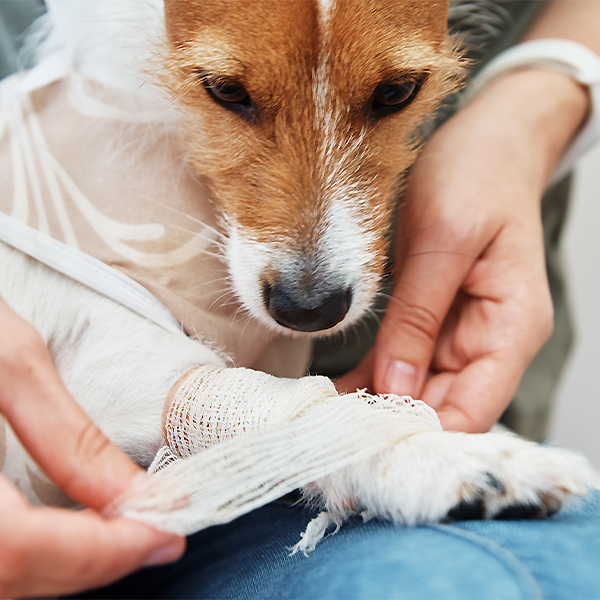
Theresa Brown says it’s important for people to have pet first aid awareness and have a kit readily available in case of an emergency.
This summer you never know when you might need to use a first aid kit for your pet. But what exactly do you need in a first aid kit? Or what do you need to do if specific emergencies arise?
Veterinarians understand that freak accidents happen, so it is important to have a basic first aid kit and also know what to do with it in particular situations such as if your pet has a laceration, anaphylactic (allergic) reaction, snake bite, heat stroke or other emergency. Not knowing basic first aid or how to respond to certain situations could seriously affect your pets' chances of survival. Theresa Brown, assistant professor of general veterinary practice at Texas Tech University's School of Veterinary Medicine, has some valuable tips for you in case of an emergency and what you need in your first aid kit.
What are some vital tips a pet owner should know about in case of an emergency? 
Stay calm and think about the basic concepts. Make sure you, other family members and pets are safe. Know your local veterinarian and emergency number or the number of a local emergency clinic if your primary care veterinarian is away on vacation. Learn basic first aid – including how to stop bleeding, how to cool a pet if too hot, how to apply a tourniquet (slow blood flow to an area), and how to pick up and safely transport a pained or hurt pet.
If a pet is injured, what are some safety tips the owner should consider in order to keep themselves and their pet safe?
Injured and painful pets can and will bite. If able, attempt to stabilize the injury or fracture before moving the pet by placing a temporary bandage or splint such as a straight piece of wood placed over a bandaged limb. Keep the pet confined in a small area, cage or cardboard box to prevent them from further injury or attempting to walk or move around. However, ensure they have enough air to breath. Muzzle the pet if required (a long sock, stocking or soft rope can be used). If a muzzle is not available, cover the head in a thick towel, blanket, or jacket before attempting to pick up while making sure they can still breath.
Take a little time to look over the pet and see where the pain or bleeding is coming from and avoid touching or picking up the patient in that area. A stretcher to transport the animal safely can be made by using a board, towel or blanket as a means of carrying the injured pet. Be sure to stabilize the pet so it does not fall off the stretcher when being transported. Watch for signs of shock (pale gums, lethargic, fast or heavy breathing) and ensure the animal is kept warm and as quiet as possible.
Can you list some scenarios that are common pet emergencies and how a pet owner should respond?
- Snake bite – Identify the snake if possible and call your veterinarian immediately. Keep your pet calm and quiet, remove their collar and position the pet to keep the bite below the heart if possible. Then transport to a veterinary clinic as soon as possible.
- Insect bites and allergic reactions (facial swellings or hives) – Call your veterinarian for advice. You may be requested to administered Benadryl.
- Trauma or fractures – Keep calm and call your veterinarian. If you are able, immediately transport carefully and safely to veterinary clinic. Otherwise, attempt to stabilize or wrap the affected area and keep the patient warm.
- Lacerations, cuts, or other animal bite wounds – Flush wounds with clean water or saline if your pet allows. Gently apply a padded bandage to the area (if able to do so safely) to control bleeding.
- Choking or breathing difficulties (pawing at mouth, gagging and appearing panicked) – Attempt to safely look inside the mouth to visualize any lodged items. If you see something, open the mouth wide using both hands. Then use one hand to grab the upper jaw and the other on the lower jaw. Attempt to dislodge the object. If unable to remove the object, use your fist to push firmly inward and upward beneath the rib cage (like the Heimlich maneuver) which may help to dislodge food or items stuck in the back of the throat. If after two quick attempts you are still unable to retrieve the object, rush to your veterinarian immediately.
- Hit by car – Carefully move your pet off the street. Then, muzzle or cover head with a blanket or towel if necessary (careful not to block their nostrils and affect breathing). Briefly assess the injuries and call your veterinarian or transport directly to them. Wrap the animal to keep warm.
- Seizures – Stay calm and talk softly to them. Move objects around the pet out of the way and ensure they are in a safe position. Write down the details of the seizure and time how long the seizures last to tell your veterinarian. Call your veterinarian immediately if you believe that your pet ate something toxic that caused the seizures. If the seizure lasts longer than 2 minutes, take them immediately to your vet.
- Burns – Run cold water over the burnt area immediately for a full 20 minutes and bring immediately to your veterinarian.
- Heat stroke (heavy panting and difficulty breathing, excessive drooling, drowsy, uncoordinated or collapsed) – Move the pet to a cool shaded area and pour cool water (not freezing cold) over the animal continuously. Allow them to drink small amounts of cool water if able to. Then transport to a veterinarian immediately.
- Eating something toxic or poisonous (e.g., chocolate or antifreeze) – If able to, transport the pet immediately to your veterinarian or emergency provider. If unable to call your veterinarian, you may be asked to administer hydrogen peroxide to induce vomiting.
- Vomiting or diarrhea – Withhold food for 12 hours and monitor the pet closely. If the pet is severely lethargic, has bloody vomit or bloody diarrhea, or symptoms have not improved after 12 to 24 hours then call your veterinarian.
- Neurologic problems (difficulty standing and moving) – Call and transport the pet to your veterinarian as soon as possible.
- Abnormal aggressive behavior – Stay safe and examine the pet from a distance. Attempt to see if there is a reason for the aggression (e.g., pain, wound, trauma/fracture, or guarding another animal). Then call your veterinarian for advice. Place the pet in a kennel or crate if able to safely.
What should a pet owner have in their first aid kit for their pets?
- Absorbent gauze pads (to stop bleeding/hemorrhage)
- Bandage material (cotton roll)
- Bandage roll to wrap around a limb
- Adhesive tape
- Scissors
- Saline or flush (to flush wounds or eyes)
- Number of syringes (small ones and large ones for flushing wounds or administering medications)
- Flashlight
- Towel or blanket (for warmth or restraint)
- Benadryl tablets (for allergic reactions)
- Exam gloves
- Hydrogen peroxide (to induce vomiting)
Are there any other things to consider?
Accidents happen and it is important to have a plan. Consider pet insurance to cover unexpected expenses. Fractured bones and other trauma can be very expensive and difficult decisions may have to be made. Be sure to have your animal microchipped and up to date on vaccinations. Consider a power of attorney for your animals in case you are out of town and are not by phone to make decisions by phone.
